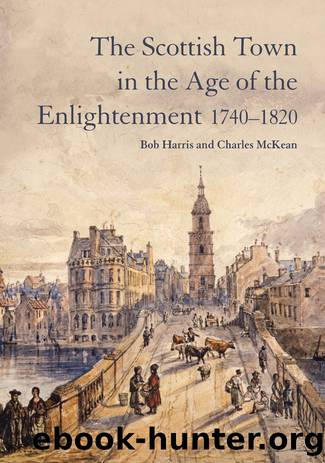The Scottish Town in the Age of the Enlightenment 1740-1820 by Harris Bob;McKean Charles;

Author:Harris, Bob;McKean, Charles;
Language: eng
Format: epub
Publisher: Edinburgh University Press
4
11
13
3
Sources: NRS, CC20, CC3; DARC, TC/JI
No published work currently exists on ownership of houses, tenements and other forms of property in Scottish towns in this period. Bits of the story can, nevertheless, be prised from the burgh registers of sasines while insurance and bankruptcy records and inventories offer additional stray clues.69 No simple picture emerges from such sources though there is sufficient to show that the implications for our understanding of wealth-holding in towns are potentially very significant, indeed.
The omission of ownership of real property from inventory valuations may well, in the first place, distort quite appreciably the picture of levels of wealth in urban society. John McGeorge, the Dumfries merchant mentioned above, had, as we have seen, a relatively modest amount of stock. His living accommodation comprised three rooms at the back of his shop, sparsely and cheaply furnished. Yet, he owned heritable property valued at £1,690. In addition to the building in which his shop was located, three separate bits of which were let, he owned a warehouse and two further shops at the market cross.70 Secondly, many individuals were active in the property market whether on a speculative basis or as aspects of family strategy and life-cycle decisions as discussed for a slightly later period by Bob Morris.71 Several Dundee merchants were extremely active in this sphere, some of whom were part of a wealthy ruling coterie led by Alexander Riddoch who dominated Dundeeâs town council for twenty years or so before 1819. Andrew Peddie was one of these. In 1810, he gained possession of two tenements and two yards on the Overgate, some ground on the south side of the Seagate, as well as two building lots, one on the west side of Castle Street and one on the newly widened Barrack Street.72 Another was Alexander Thoms of Rumgally who seems to have owned five or six separate tenements or parts of tenements as well as the âlands of Wester Clepington and the Acres commonly called Hogsfauldâ.73 Riddoch was a relentless accumulator of pieces of urban property as well as a small estate in Angus in 1796. Riddochâs rise to civic prominence is yet further demonstration of the relative fluidity of provincial urban society in this period. His origins were not in Dundee or among the townâs mercantile community; rather, he arrived in the 1760s from the rural Perthshire parish of Monivaird. His considerable wealth at this death â his personal estate was valued at £12,000 â derived from diverse trading and business activities, including moneylending and astute (some might say corrupt) speculation in urban property.74 To follow him in this, in all its twists and turns, is probably now impossible. The register of sasines shows as many forty-three transactions involving Riddoch between 1781 and 1819.75 Peddie, Thoms, and Riddoch were probably only slightly unusual in the scope of their activities and in their willingness to use their position of public office to expedite their ends though, undoubtedly, they had their counterparts in other towns.76 They were also very much part of the local merchant elite.
Download
This site does not store any files on its server. We only index and link to content provided by other sites. Please contact the content providers to delete copyright contents if any and email us, we'll remove relevant links or contents immediately.
The Vikings: Conquering England, France, and Ireland by Wernick Robert(79210)
Ali Pasha, Lion of Ioannina by Eugenia Russell & Eugenia Russell(39936)
The Vikings: Discoverers of a New World by Wernick Robert(36828)
The Conquerors (The Winning of America Series Book 3) by Eckert Allan W(36714)
Cecilia; Or, Memoirs of an Heiress — Volume 1 by Fanny Burney(32085)
Cecilia; Or, Memoirs of an Heiress — Volume 3 by Fanny Burney(31476)
Cecilia; Or, Memoirs of an Heiress — Volume 2 by Fanny Burney(31431)
Empire of the Sikhs by Patwant Singh(22778)
Hans Sturm: A Soldier's Odyssey on the Eastern Front by Gordon Williamson(18338)
The Secret History by Donna Tartt(18250)
Cat's cradle by Kurt Vonnegut(14799)
Sapiens: A Brief History of Humankind by Yuval Noah Harari(14004)
Pimp by Iceberg Slim(13818)
Talking to Strangers by Malcolm Gladwell(12909)
Norse Mythology by Gaiman Neil(12875)
Leonardo da Vinci by Walter Isaacson(12828)
Underground: A Human History of the Worlds Beneath Our Feet by Will Hunt(11855)
4 3 2 1: A Novel by Paul Auster(11831)
The Radium Girls by Kate Moore(11644)
